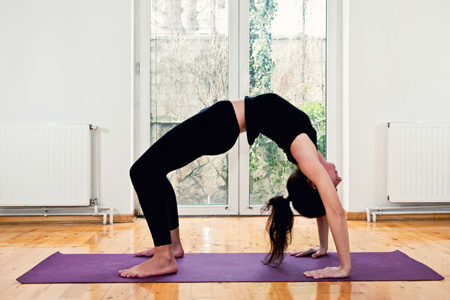 Backbends (or heart openers for us yogis) are a common pose that, when done properly, can increase mobility, strength, improve posture and help alleviate pain. Let’s take a look at whether the backbend you're doing is truly a backbend, or if it's something else entirely.
Backbends (or heart openers for us yogis) are a common pose that, when done properly, can increase mobility, strength, improve posture and help alleviate pain. Let’s take a look at whether the backbend you're doing is truly a backbend, or if it's something else entirely.
What Does ‘Opening the Heart’ Mean?
When we backbend, the goal is to ‘open the heart’, not literally, but rather to increase the mobility of the musculoskeletal area around the heart, which is the rib cage and thoracic spine (upper back to mid-back area). And in backbending, we specifically do this by bending the spine backward, which is called spinal extension.
The area of our rib cage and thoracic spine is a place that tends to be extremely immobile in most people. Sitting for long periods and slouching can stiffen this area over the years and even cause pain.
When one area of our body becomes stiff and immobile, other areas of our body have to compensate. The area just adjacent to it will have to mobilize more to allow your body to move through life and do the things you want it to do, and the spinal area is no exception. It’s no wonder that around 80% of us will suffer from low back pain at some point in our lives!
Sitting up Straight
We have all been told to sit up straight, not realizing that this is more of a postural preference created by society that can have ill effects. If we think about sitting up straight in anatomical terms, what we’re attempting is spinal extension, or to increase the space between our vertebrae.
But, because nearly everyone’s thoracic spine is immobile, if we want to sit up straight, our “locked up” thoracic spine and rib cage are actually much more likely to simply tilt forward as a whole unit, not as 12 separate vertebrae.
Rather than a small amount of healthy extension happening at all 12 vertebral segments, a large amount of unhealthy movement will happen right where the rib cage “sits” on top of the lumbar spine, or T12/L1. The action that happens at this place is not spinal extension, but rather what’s known as vertebral shear. The shearing forward of the rib cage relative to the lumbar spine is so common that it’s often referred to as simply rib shear or rib thrust.
What is Rib Thrust and Why is it Bad?
Hanging out with your ribs sheared forward is actually very common amongst both regular people and yogis. Unless you’re aware of the issue and are consciously working toward re-aligning your body, you are most likely a “rib-thruster”.
So, why is rib thrusting a bad thing if it makes us more comfortable? Well, let’s think about the spinal cord. What do you think happens to your spinal cord when your rib cage shears forward right where it sits on top of the lumbar spine? It becomes kinked. A kink in the spinal cord can compress the intervertebral discs in your lower back.
Everyone’s thoracic (upper) spine should curve outward ever so slightly. The spine curves for a reason, and when we sit up too straight, that curvature goes away.
Rib Thrust and Backbends
Because most of us are already “rib-thrusters”, yogis need to be extra mindful when it comes to backbends. Think of the crescent pose - the goal is to open up the thoracic spine while performing spinal extension, however, many people will perform this pose by rib thrusting thus compressing the lower back.
When doing a backbend, focus on stability over mobility. A great range of motion isn’t beneficial if the tissues of the body are being negatively affected.
So what about some of yoga’s more intense backbends like the upward facing bow pose, the full pigeon pose, and king dancer pose? While some people do these poses for fun, or to strike a pose for Instagram, they are probably also doing them because they’re supposed to be extremely beneficial for the spine. But if you aren’t able to stabilize where you are mobile (rib shear) so that you can mobilize where you are too stable (thoracic spine), these poses really won’t offer you anything in terms of positive change in your body and will actually promote poor posture habits.
After learning more about the science of how the body moves, deep poses like backbends, and what they can offer our body, deserve a closer look. So, do some exploration, and see where you fall on the spectrum—where are your ribs hanging out?
